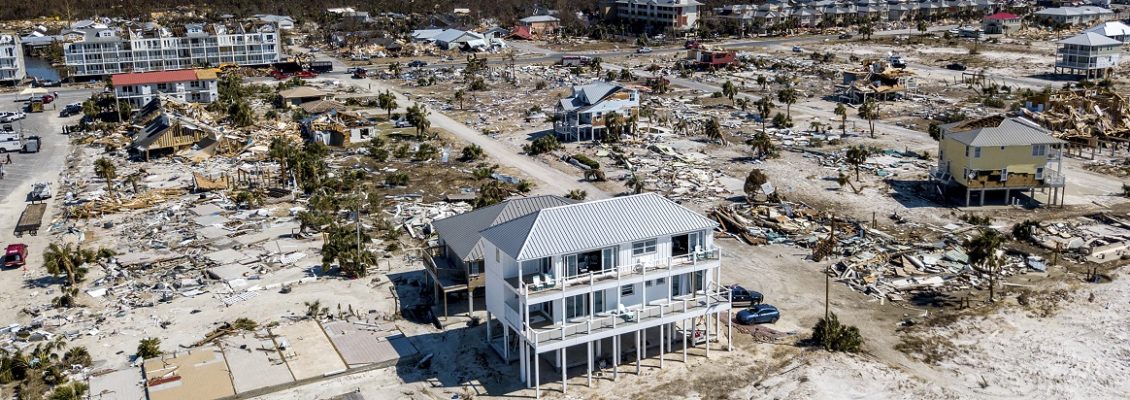by Pat Stanton
Record-breaking Hurricane Michael devastated coastal communities last fall. Because severe weather events on Florida’s Panhandle occur less frequently than on its Atlantic coast, that region was unprepared for such a potent storm. Panhandle building codes were less stringent than elsewhere,* and residents paid a steep price.
A famous picture from The New York Times shows one house unscathed in Mexico Beach, amidst flattened home sites. Why did this building withstand the storm? The owner worked with experts to design it for extreme weather events, using insulated concrete forms rather than taking a typical “design-to-code” approach. Learning this fact led me to consider the range of benefits that resilient buildings provide to their owners and occupants.
Resilient building enclosures and wall assemblies will mitigate effects of strong winds, fire, and extreme temperatures as well as providing the commonplace money-saving and other advantages of energy efficiency. The construction code requirements needed to address climate risks are complementary with efficiency codes, e.g., windows required to meet “wind codes” are also more highly efficient windows. Setting codes for multiple resilience factors for each investment type will provide building owners and communities with maximum benefits.
Beyond “Passive Survivability”
The Fourth National Climate Assessment predicts that across the US, extreme weather events including floods, hurricanes, wildfires and heat waves will drastically rise in intensity and frequency. A higher-performing building enclosure – due to the owner’s design, to updated building codes, or to energy efficiency retrofits – has a better chance of surviving an extreme event and can provide increased resilience. Benefits include better retention of a building’s desired temperature during a power outage, as well as increased durability. An efficiently constructed building also may require a smaller backup generator, using less fuel.
With planned increases in the electrification of transportation and heating becoming more prevalent, buildings designed to stay comfortable – and that require less backup power during an extended outage – provide even more value. Grid operators would have more options if they could be confident that the majority of buildings remain safe for occupants longer during heat waves or cold snaps. With more efficient structures, resilience could rely less on the ability for centralized generation to withstand extreme events and more on structures that can remain habitable even while distribution lines are damaged.
A blog by Grace Relf (Senior Research Analyst, Energy Policy, ACEEE) describes resilience benefits of energy efficiency, summarized here:

Source: https://aceee.org/research-report/u1508
Advice From Experts
As 2019 proceeds, we know to expect more frequent and severe weather events. What practical approaches can national, state and local officials use to prepare communities and local economies? I recommend the National Association of State Energy Officials (NASEO) report on disaster mitigation and rebuilding. Focusing on the residential sector, it advocates for state energy officials to create policies that help prepare structures for extreme events. NASEO suggests planning strategies that include “building public awareness around the value of energy efficiency and resiliency in homes,” building partnerships with “state and federal emergency management agencies, creat[ing] energy efficiency,” and “adopt[ing] and implement[ing] energy-efficiency code provisions.”
For example, the City of Boston recently changed its utility planning process to include preparation of infrastructure and other assets affected during extreme weather events. Adopting policies that support energy efficiency and provide resilience benefits to communities also create and sustain local jobs. These “co-benefits” ripple out, providing an important cumulative boost to local and regional economies as they also help to improve health and well-being.
I Invite Your Participation
E4TheFuture’s Faces of EE initiative highlights more than 1500 workers whose passion for better American buildings also provides more comfort and energy savings benefits. While our 2018 Energy Efficiency Jobs in America report shows 2.25 million jobs in energy efficiency, this number could be much higher with additional smart investment and resilience planning.
Please be in touch if you would like to join E4TheFuture’s effort to bring efficiency policy into state and local resilience planning. Contact policy@e4thefuture.org. You may also participate in our Faces of EE campaign. Moving into uncharted territory, we need all hands on deck!
–Pat Stanton is E4TheFuture’s Director of Policy
